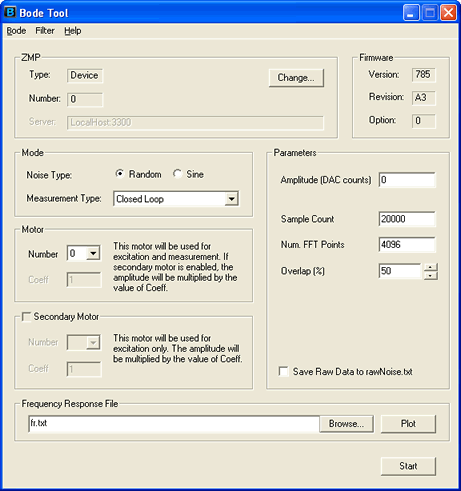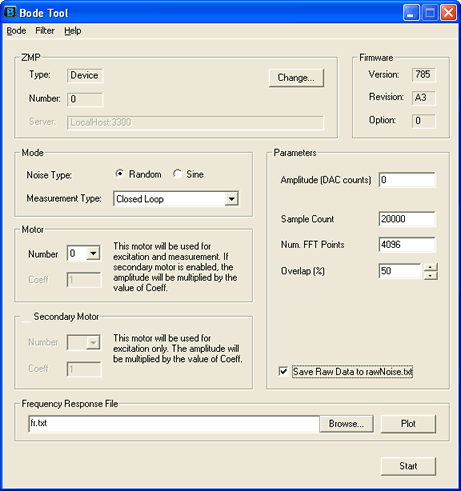Running an FFT Measurement
To make an FFT measurement of the system, select
Random as the Noise type.

Before performing an FFT measurement, several
parameters must be set:
Measurement Type
Amplitude
Standard Firmware:
— Motor Number
MechaWare Firmware:
— Model number of downloaded model
— Active noise block (Custom or User Buffer)
or
— Active motor block
(Closed or Open Loop)
Note: Number Samples, Number FFT Points, Overlap %, and Saving Raw Data from the FFT Test must also be set as described below.
Number Samples
Number Samples sets the number of samples
of data that will be collected. Keep in mind that the amount of
time needed for the test is set by the sample rate. For example,
20,000 samples at a 2,000 Hz sample rate will result in 10 seconds
of excitation. Increasing the number of samples will result in a
longer test and less noise in the final measurement. The number
of samples must be greater or equal to the number of FFT points.
Number FFT Points
Number FFT Points sets the resolution of
the FFT measurement. The resolution of the FFT measurement is the
Sample Rate / Number FFT Points. Low resolutions of FFT produce
the least amount of noise, whereas high resolutions of FFT yield
more noise.
For example, at a 2,000 Hz sample rate and 4096
FFT points, the FFT resolution is 0.49 Hz.
Increasing the Number FFT Points will increase
FFT resolution and make the measurement noisier. By lowering the
FFT resolution, you are essentially averaging more than one frequency
together, thereby lowering the noise. (The FFT algorithm is designed
to be efficient for most numbers of FFT Points.) The FFT algorithm
is most efficient when using powers of 2 for the Number FFT Points.
The parameter "Number FFT Points"
must be a number that can be factored to a largest prime number
of 37 or smaller. If "Number FFT Points" does not satisfy
this requirement, the following error window will be shown.

If you run the Bode Tool in an automated
test from the command line and choose "Num FFT Points"
with a prime greater than 37, then the Bode Tool will automatically
increase "Num FFT Points" for you until the largest prime
number is less than 37.
Known Limitation: Number of
FFT Points can not exceed 19000 points. Higher values cause truncation
of data at high frequencies.
Overlap %
Use the Overlap % parameter to adjust the
overlap between FFT segments. This number can be adjusted from 0
to 50. A value of 50% is a good default setting.
Saving Raw Data from the FFT Test
By default, the Bode Tool does not store the raw
noise excitation data to files. To save the raw excitation data
to a file, check the Save Raw Data to rawNoise.txt box. The data is saved
in a file named "rawNoise.txt" in the
Bode Tool working directory.

The data is in the following tab delimited format:
Sample counter [tab] excitation signal [tab] input signal [tab]
output signal
Here is a section of a sample rawNoise.txt file:
| 29000222 |
-43.130937 |
-41.130936 |
36 |
| 29000223 |
-1.659435 |
0.340565 |
36 |
| 29000224 |
9.918809 |
11.918809 |
37 |
| 29000225 |
5.444968 |
7.444968 |
36 |
| 29000226 |
13.624221 |
15.624221 |
37 |
| 29000227 |
-17.655438 |
-15.655437 |
37 |
| 29000228 |
-34.949321 |
-32.949322 |
37 |
| 29000229 |
6.816512 |
8.816512 |
37 |
| 29000230 |
-34.872639 |
-32.872639 |
37 |
Previous | Next |
